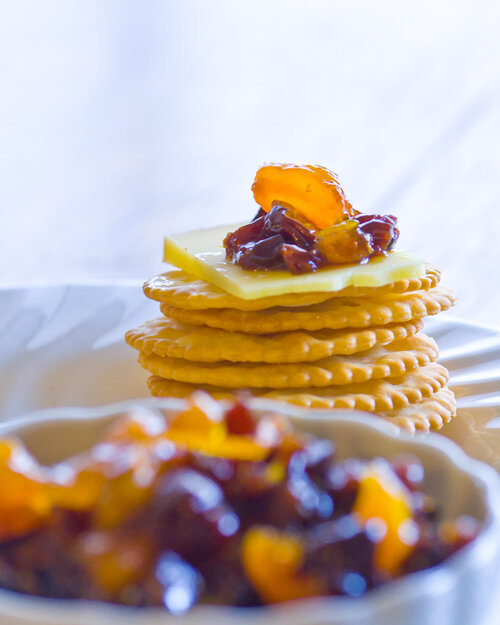How to Serve a Cheese Course the French Way
The Cheese Course. Photo by my good friend Richard Swearinger
The French cheese course is a wonderful way to bring a lot of fascinating, varied flavors to the table, without a lot of work. For some reason, however, most Americans haven't really keyed into the pleasures. I often wonder why.
Maybe it's because we so often serve cheese as an appetizer (or, we serve super-cheesy appetizers). Having learned a lot from the French, that's something I never do anymore. After all—why do you want to fill your guests up with something rich, gooey, and appetite-dousing at the very beginning of a meal, when there's so many other good things to come?
In fact, in most French homes I've dined in, the nibbles served with cocktails have been very simple and light, just an appetite-rousing bite enjoyed to refresh and sustain guests before the move to the table.
No kidding. This is what I was served in the home of a Bordeaux winemaker as an appetizer. The loveliest in-season tomatoes she had, with a nice Bordeaux blanc. Then we moved to the table for a feast.
Maybe we haven't tapped into the cheese course because—with all the cheeses out there in the world—it's hard to figure out what to serve. And how to serve it.
The fact is, the way the French present a cheese course in the home is usually very simple indeed. Here's how to do it, in five easy steps:
When to Serve the Cheese Course
The cheese course always comes at some point after the main course. It can be served before dessert or as dessert.
How to Choose Cheeses for a Cheese Course
There are a few ways to go about it, none of them wrong. I enjoy “bringing home the barnyard”—that is, serving a cow’s milk cheese, a sheep’s milk cheese, and a goat’s milk cheese. One my favorite threesomes is Comté (cow), Ossau-Iraty (sheep), and a soft-ripened goat cheese, not just because they taste great and provide some fascinating contrasts, but also because I know I can use whatever isn’t eaten in my cooking.
For everyday meals, the cheese course can be much more simple than that—perhaps just a piece or two of local cheese and some bread.
I like to serve the cheese course with a tangle of lightly vinaigrette-tossed salad.
What to Serve with a Cheese Course
The only things you absolutely need are a knife, a fork, and some bread. Occasionally—and especially if the cheese course will be followed by dessert—the cheeses are accompanied by a small salad to contrast the rich cheeses, as in the photo. You can use any flavorful, vinaigrette-tossed greens.
If the cheese course will not be followed by dessert, sometimes—though certainly not always—a little honey, preserves, or fresh fruit can be served with the cheese course (with of course, the bread). Good preserves, fresh fruit, or even some honey can provide that little bit of sweetness that makes the course seem more dessert-worthy.
If no dessert will follow the cheese course, then it’s nice to serve the cheese with fresh fruit, fruit preserves, or this fruit compote, which is from Everyday French Cooking.
How to Present the Cheese Course
Though you can plate the cheeses individually—1/2 to 1 ounce of each cheese suffices—a French cook would be more likely to simply place the cheese tray in the middle of the table and let everyone help themselves à volonté (as much and as often as they wish). If they're presenting a salad with the cheese course, they might plate the salad for everyone first.
What Wine to Drink with the Cheese Course
In France, the wine you enjoy with your cheese course is most often the wine you’ve been drinking with your main course. You simply finish the bottle on the table. However, if you find yourself needing to open another bottle, a good choice is a Riesling—its brightness and tang offer a nice contrast to the richness of cheeses. If you seek red, try a cru Beaujolais, a lighter-style fruity red that’s cheese friendly.
Champagne always works wonderfully, too.
How to Store Leftover Cheese
Waxed paper doesn’t cut it–the cheese can dry out and get hard. Plastic wrap doesn’t let it breathe. The solution? A specially designed cheese wrap. I've discovered the solution: Formaticum Cheese Storage Bags.
Made in France (a country that knows a thing or two about cheese), the porous bags allow the cheese to breathe, yet keep it from drying out. They also make post-party cleanup quick: Simply place the leftover cheese in the bag and fold over the top. No time-consuming origami-style re-wrapping needed. (However, if you do like wrapping cheese, you can also buy Formaticum Cheese Paper.)
Formaticum Cheese Storage Bags
How You Can Help Support My Work
Did you enjoy this post? If so, please consider supporting my work. Here’s how:
• Order something through Amazon through one of the links on this site. I’ll receive a small commission on anything you order, at no additional cost to you.
• Consider purchasing my book, “Everyday French Cooking: Modern French Cuisine Made Simple” for more easy, everyday French recipes.
• Sign up for my All Things French monthly e-newsletter.
• Follow me on Facebook or Instagram.
• Or, if you simply want to make a small donation, simply PayPal me.







